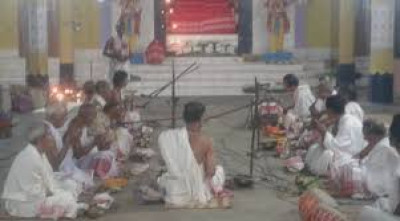Detailed Notes
Historically, the origin of Paal Naam dates back to the 16th century, during the time of Srimanta Sankardeva and his disciple Madhavdeva, the pioneers of the Neo-Vaishnavite movement in Assam. As per legend, when Madhavdeva was imprisoned by the Ahom King Suhungmung (Dihingiya Raja), Sankardeva’s followers began a continuous prayer for his safety. Their unbroken devotion led to Madhavdeva’s safe return, and from that event, the practice of Paal Naam began as a mark of faith and gratitude.
The Auniati Sattra is renowned for organizing Paal Naam on a grand scale during the Kati month (October–November) every year. The event lasts for five days, where devotees from all over Assam gather to take part in the uninterrupted prayers. The Namghar (temple hall) becomes the spiritual center, with a symbolic boat carrying the Bhagawata Purana placed in an east-west direction, representing salvation or bhavatarana. The devotees sit on either side of the boat and chant in harmony, imagining the Manikut (sanctum) as Vaikuntha on earth.
Each day of Paal Naam consists of three sessions or turns (pals) — the Ag Pal (early turn), Maj Pal (middle turn), and Sesh Pal (final turn). At the end of every turn, the Satradhikar (head monk) and other spiritual leaders bow before the devotees, symbolizing humility and equality in the Vaishnavite faith. Offerings such as rice and salt are made, as in ancient times, salt was regarded as valuable as gold.
The festival concludes with a ceremonial pradakshina (circumambulation) by the Satradhikar, followed by reinstalling the Bhagawata in the Manikut. Paal Naam is thus not just a prayer ritual but a living expression of Assamese spirituality, cultural identity, and the enduring teachings of Sankardeva and Madhavdeva.
FAQs with Short Answers:
-
What is Paal Naam in Assamese culture?Paal Naam is a continuous group chanting of God’s name in rotation, practiced in Assam’s Vaishnavite Sattras.
-
Who started the tradition of Paal Naam?It began during the time of Srimanta Sankardeva and Madhavdeva in the 16th century.
-
Where is Paal Naam celebrated on a large scale?The Auniati Sattra celebrates it grandly during the Kati month.
-
What does the word ‘Paal’ mean?‘Paal’ means turn or rotation, referring to groups chanting by turns.
-
How long does Paal Naam last at Auniati Sattra?It is observed for five consecutive days.
-
What offerings are made during Paal Naam?Devotees offer rice, salt, and other items as a mark of devotion.
-
What is the symbolic meaning of the boat placed in the Namghar?The boat symbolizes bhavatarana, or the soul’s journey toward salvation.
-
How many sessions are there in a day during Paal Naam?Three - Ag Pal, Maj Pal, and Sesh Pal.
-
What is the role of the Satradhikar during Paal Naam?The Satradhikar leads the prayers, performs rituals, and bows to devotees.
-
Why is Paal Naam important for Assamese culture?It represents devotion, unity, and the living legacy of Assam’s Vaishnavite heritage.
